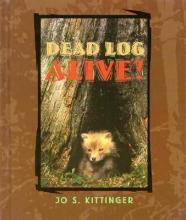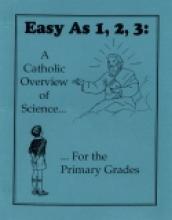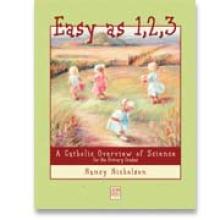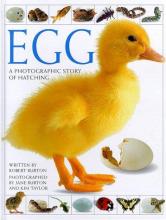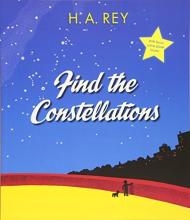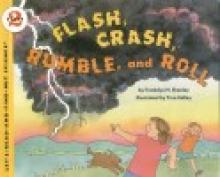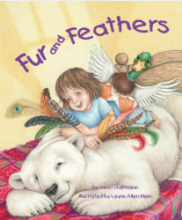Science Elementary
Christian Kids Explore Chemistry
Dead Log Alive!
This book provides an interesting and detailed look at what comes to live in and around a dead log – woodpeckers, squirrels, mushrooms, fungi, moss, molds, porcupines, foxes, snakes, scorpions, millipedes, centipedes, pill bugs, salamanders, ants, termites, and beetles. Includes many interesting color photos and details about each species, how to tell them apart and much more. The book also includes an index, a glossary and suggestions for further reading.
Easy As 1, 2, 3: A Catholic Overview of Science For the Primary Grades
This program provides families who like to use living books with a Catholic framework from which to study science. It is not a textbook but rather is 40 pages, of which approximately half are outlines, that are three hole punched and ready to go into your notebook. The parent that uses this will find the eleven units of science outlined very handy for creating their own program and clearly laid out so that they can tuck personal notes and activities into their notebook using the 40 pages as their point of organizing. The manual begins with an explanation of how the outline can best be used and includes suggested resources and supplies. Each units focus (animals for example) is broken down by grade and includes a listing of the main headings that should be studied (e.g. Mammals, habitats and others in grade 1, amphibians, migration and others in grade 3). The author also includes a "find out" paragraph that includes special topics that parents should bring out.
Easy as 1,2,3
This is the second edition of a 1998 volume by CHC with the same title. While it has an all-new layout, much of the content remains the same.
Egg: A Photographic Story of Hatching
When you think of eggs hatching, do you tend to think of birds and chicks? Think again! Reptiles, fish and insects can hatch from eggs as well. This book provides the photo stories of the hatching of 27 different animals including Ostrich, Moorhen, Japanese Quail, Starling, Leopard Tortoise, Cornsnake, Leopard Gecko, Ladybug, Common Frog, Great Crested Newt, Goldfish and Kerry Slug. Each hatching includes numerous photos with detailed descriptions of the process and how long it takes. A final photo generally shows the creature a day or two later.
The introductory pages provide comments and illustrations on "What is an Egg?", "Who Has Eggs?", and "The Developing Egg" (with drawings of the development of a baby chick within its egg).
Find the Constellations
I've always loved looking at the stars, but have never been able to identify anything but the big dipper on a starry night. For many years, I've wanted to learn more, but with the busyness of life, this goal has long eluded me. Enter ... Find the Constellations by H.A. Rey. Over the past few weeks, my two oldest children and I have started identifying the constellations with the help of this book and The Stars: A New Way to See Them (by the same author). We've had a great deal of excitement and enthusiasm around 10:00 pm when I summon those children who are still awake to see if we can find anything. With flashlight and books in hand we step outside into the dark. We look up and start to focus. After studying the pictures ahead of time, several constellations start jumping out. We move back and forth between book and sky and the excitement increases. Well, we haven't learned lots yet, but we are now able to identify five or six constellations and are slowly increasing our base knowledge.
This simple book is very child-friendly and moves the reader back and forth between what the stars really look like and simple, memorable stick figures to help keep them (and their names) in our heads. One helpful feature in the carefully drawn charts is the differentiation between brighter and less-bright stars (a very important feature in identification). The book includes some quizzes to help children remember the constellations better and, again, differentiate between the stick-figure drawings and the actual "look" of the constellation. The author also includes: some of the stories behind the naming of the constellations; information about the changes in our sky view at different times of the night and different times of the year; tips for star-gazing; and overviews of the planets in our solar system and tips for viewing them. The book wraps up with some interesting information about what it takes to travel to the moon or to Mars as far as distance, speed and navigation goes. He takes this back to the idea of why it is a good thing to learn the constellations.
All of the information in this book is aimed at viewing the night sky with the naked eye rather than a telescope. There is an extensive index in the back which includes the Latin and Greek names of the constellations (such as Ursa Major and Bootes), but the text uses the English names (except for specific names of stars, such as Vega and Arcturus). The book has been revised numerous times since 1954 and the most recent edition includes location of the planets through 2006. Highly Recommended!
Revised many times since original publication, the book details here are for the 2016 edition.
Flash, Crash, Rumble and Roll
This simple, nicely illustrated (cartoon-like pictures) children's book explains important concepts of science in a very easy-to-understand fashion. The reader is introduced to the way thunderclouds form and where thunder and lightning come from. The scientific content is substantial and very accessible. The story line is rounded out with tips for staying safe during a storm. My children have been fascinated by the details about the inside of a thundercloud, how fast sound and light travel, how you can measure the distance thunder travels and more. This title has been a big favorite with all of my children for a number of years and, rather than being made nervous by the dangers mentioned in the book, a little knowledge seems to be a comforting thing.
Copyrights 1985/1999
For the Beauty of the Earth
Like many Catholic Home schooling families, providing a Catholic education was number one on the list of reasons my husband and I wanted to home school. In addition, we wanted a rigorous education, and one that emphasized the beauties of truth and love. Translating these goals into a curriculum is an on-going challenge. Sometimes the books that do a good job presenting a particular subject do it without the light of the Faith. Other times, books that are "solidly Catholic" are also unattractive and uninspiring. We have had to compromise in a lot of areas.
Two that we have not had to compromise in are science and history, and this is largely due to the Catholic school supplements produced by James Leek. These two are among the most excellent resources I have come across in home schooling. They include interesting material for study and careful explanation of an approach to education that is beautifully in keeping with our holy faith. In themselves, these explanations are worth reading and incorporating into your teaching.
In science, for example, Mr. Leek explains the integrating principles for a Catholic science education. Ultimately, our aim is to better know the Creator of everything. Science study also has remote ends: that we develop a respect for God's creation, and learn to contemplate and reflect on it, and that we exercise our minds to improve life and serve our fellow men. At the same time, science has its proximate and immediate ends: to learn how the world works and to take in sensory data of the physical reality around us.
These principles are very well realized in Leek's science supplement. For the Beauty of the Earth includes a textbook with literary selections organized around the common subject matter of science. The lyrics of the beautiful hymn from which this program draws its title provide the organizing system. In addition to "the beauty of the earth" (weather, metals, energy), we have chapters on "the glory of the skies" (stars, the sun), "hill and vale and tree and flower" "the mystic harmony linking sense to sound and sight" (insects, spiders, mammals), and "the joy of human love" (the senses, emotions, the will.)
The corresponding teacher's guide builds on the readings with questions and activities that take the student from considering the text, to observing the natural world, to admiring God's handiwork, and finally, to the religious analogy. An example to illustrate this progression would be the reading of "Phaeton and Apollo." After the selection is read, the student is asked a series of questions on the text: Who was Phaeton? Describe the court of the sun, etc. Next, students are asked to make some observations about the sun: Where does it rise and set? Does it actually move? What makes it appear to move? Then they are asked to consider the sun's role in life on our planet, and finally, to how the sun is like God, how its marvelous working points to the existence of God.
Questions and activities are broken into grade levels so that this program can be used throughout the elementary years. My first reaction when I looked at For the Beauty of the Earth was to think that this was a liberal arts soft-pedaling of the hard subject of science. But after I carefully read the author's introduction, I decided it could be so much more than that, and it more than met those expectations. We used it alternately with our regular science text, allowing the literary selections and projects to set the tone for our textbook's coverage. Along with enjoying some good stories, memorizing poems and scriptures, doing some fun projects (like building a humane mousetrap), I found that the sense of wonder created through the program carried into the rest of our textbook consideration of each topic. The course is cross-referenced with many of the most popular school science text series from the time it was published (early 1980s).
Fur and Feathers
In Sophia's dream, all the animals had their coats blown off and so she has to make new ones for them, adding her own special touches. This is the story of "fur and feathers" which introduces young children to animal classification.
The story has a good variety of common animals with different coats. A few parts are a bit contrived, like the frog finding the slime, but otherwise the story is engaging. The "For Creative Minds" section at the end of the book contains activities based on animal classification.
Most of each two-page spread is dedicated to the lovely artwork of animals in Sophia's bedroom. You can see a preview document or video at http://www.sylvandellpublishing.com/bookpage.php?id=FurFeathers
Fur and Feathers is a wonderful beginning book to introduce children to scientific classification, and even to good observation. Read this before your next trip to the zoo!

